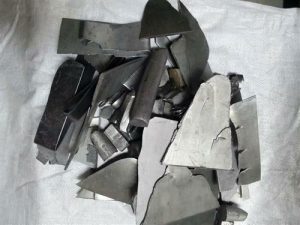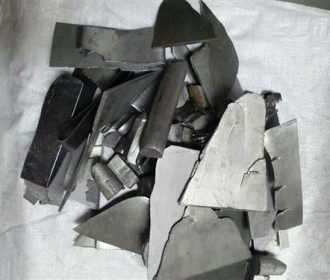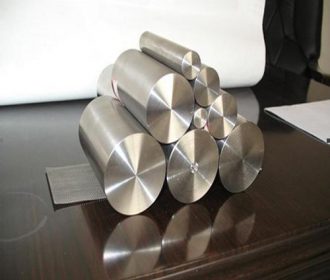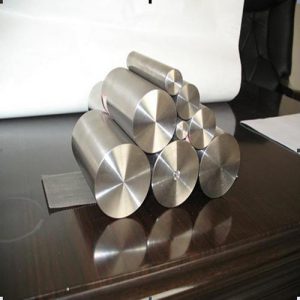Tantalum Carbide (TaC) is an extremely hard refractory ceramic material. It has a metallic luster but may also be found as a dark to light brown powder, and it burns in air with a bright flash and is slightly soluble in acids.

Tantalum carbide has excellent physical and chemical properties, such as high hardness, high melting point, good electrical conductivity, thermal shock resistance, good resistance to chemical corrosion, high resistance to oxidation and catalytic properties, etc. which make tantalum carbide widely used in industrial and military fields.
The main uses of tantalum carbide are cemented carbide, capacitors, electronic components, high-temperature components, chemical equipment, and armor-piercing projectiles.
Cemented carbide
Tantalum carbide plays an important role in cemented carbides. It improves the properties of the alloy by improving the fiber structure and phases transformation kinetics, giving the alloy higher strength, phase stability, and processability.
Tantalum is particularly effective in promoting nucleation and preventing precipitation of carbon in the core crystalline brittle film formed during the late solidification. Its main functions are: (1) preventing the growth of cemented carbide grains; (2) forming a third dispersed phase other than tungsten carbide (WC) and Co together with titanium carbide (TiC), thereby significantly increasing the thermal shock resistance and crater wear resistance of cemented carbide and improves its red hardness.
Electronics industry
In recent years, transition metal carbides have attracted much attention due to their chemical stability, high hardness, strong resistance to oxidation and corrosion, and low electrical resistivity. Carbide nanomaterials have shown great potential in metal coatings, tools, machine parts, and composites. Of all the carbide nanowire materials, silver carbide is one of the most popular materials and one of the most promising materials.
Tantalum carbide not only inherits many advantages of carbide nanomaterials but also has its own unique side, such as high hardness (Mohs hardness of 9-10 at normal temperature, high melting point (about 3880 ° C), high Young’s modulus (283-550 GPa), strong conductivity (32.7-117.4 μΩ•cm at 25 °C conductivity) ), high-temperature superconductivity (10.5K), chemical corrosion resistant candle and thermal shock capacity, high catalytic activity for ammonia decomposition and hydrogen separation.
At present, tantalum carbide powder and tantalum carbide whiskers have been prepared by carbothermal reduction, thermal plasma, solvothermal, sol-gel, microwave heating, alkali reduction, and self-propagating high-temperature synthesis, and high-frequency induction heating sintering.
Superalloy
Among the carbides, the most refractory resistance is tantalum carbide (TaC) (melting point 3890 ℃) and niobium carbide (HfC) (melting point 3880 ℃), followed by zirconium carbide (ZrC) (melting point 3500 ℃). At high temperatures, these materials have excellent mechanical properties, far exceeding the best polycrystalline graphite, especially tantalum carbide, which is the only material that maintains certain mechanical properties in the temperature range of 2900 ℃ to 3200 ℃. However, its shortcoming is that it is extremely sensitive to thermal shock, and the low thermal conductivity and high thermal expansion coefficient of carbides have become the biggest obstacles in the application of aerospace materials. The addition of tantalum carbide to the carbon/carbon composite material will result in higher thermal conductivity and lower thermal expansion conditions and will exert the oxidation resistance and ablation resistance of the refractory metal.
Stanford Advanced Materials supplies high-quality tantalum products to meet our customers’ R&D and production needs. Please visit https://www.samaterials.com/ for more information.
Reference
[1] Hassine N.A, Biner JG.P, Cross T E .Synthesis of Refractory Metal Carbide Powder via Microwave Carbontherm al Reduction [J]. Int. J. of Refractory Metals & Hard Materials, 1995, 13:353-358
[2] Tsutsumoto T. Improvement of Tafilament for diamond CVD [J].Thin Solid Films, 1998, 317:371-375.
[3] Souza C.P, Favoto C, Satre Petal. Preparation of tantalum carbide from an organometallic Preeursor [J].Brazilian Journal of Chemical Engineering, 1999,16(l):l-6.
[4] Lingmu Shou et al. The Different Effect between TaC and NbC on Cemented Carbide [J].Powder &Powder Metallurgy, 1983; 30 (7): 263.
[5] Suzuk H, Yamamoto T. Effects of Carbon Content on the Properties of Tungsten Carbide -Tantalum Carbide -10% Cobalt Cemented Carbides[J].Inter J of Powder Metallurgy,1967 ; 3(3):17.



Recent Comments